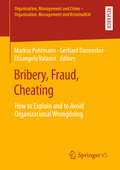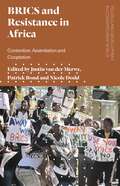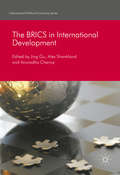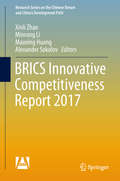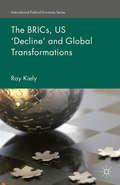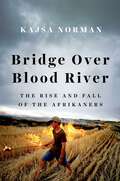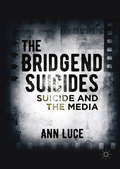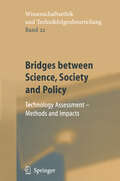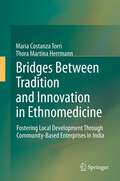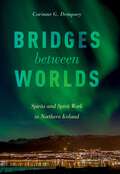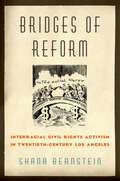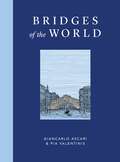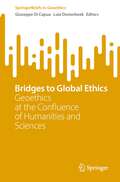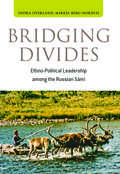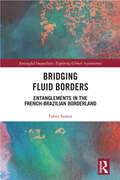- Table View
- List View
Bribery and Extortion: Undermining Business, Governments, and Security (Praeger Security International)
by Alexandra Addison WrageBribery plays a significant role in international criminal activity. Terrorists pay bribes. Money-launderers pay bribes. Those who traffic in people, narcotics, and illegal arms pay bribes. People pay immigration officers not to ask, customs officials not to inspect, and police officers not to investigate. Bribes follow patterns that are not at all mysterious to the officials, salesmen, and citizens who seek them and pay them. Using a series of international cases, Wrage examines bribery, peeling back the mystique and ambiguity and exposing the very simple transactions that lie beneath. She shows how these seemingly everyday transactions can affect security, democratization, and human aid. Examples from around the world help to illustrate the nature of the problem and efforts at combating it.Bribery plays a significant role in international criminal activity. Terrorists pay bribes. Money-launderers pay bribes. Those who traffic in people, narcotics, and illegal arms pay bribes. People pay immigration officers not to ask, customs officials not to inspect, and police officers not to investigate. At corporate headquarters in the United States, it can be easy to dismiss modest bribes in distant countries as an unfortunate cost of doing business. Bribes follow patterns that are not at all mysterious to the officials, salesmen, and citizens who seek them and pay them. Using a series of international cases, Wrage examines bribery, peeling back the mystique and ambiguity and exposing the very simple transactions that lie beneath. She shows how these seemingly everyday transactions can affect security, democratization, and human aid around the globe.Bribery and Extortion presents a clear picture of the world of bribery and the havoc it can wreak on whole populations. Wrage covers commercial bribery, administrative and service-based bribery, and extortion. She considers bribery and extortion at both high levels of government and lower levels on the street. Examples from around the world help to illustrate the nature of the problem and efforts at combating it. The book concludes with practical suggestions and an assessment of current efforts to stem the tide of bribery and restore transparency to everyday transactions in all realms.
Bribery, Fraud, Cheating: How to Explain and to Avoid Organizational Wrongdoing (Organization, Management and Crime - Organisation, Management und Kriminalität)
In the fight against organizational malpractice and organized crime, both international guidelines and national regulations have become stricter. Nevertheless, the results seem not to reach the expected change. Corruption scandals involving large companies, political parties, sports organizations, hospitals, etc. have not come to an end. In order to explain the collective illegality within and through organizations of different sectors and embedded in different cultures, this conference proceedings gathers articles about corporate and organized crime by international renowned scientists and experts. The focus is on similarities and differences in current corruption cases and other forms of crime as well as questions about conventional and alternative prevention measures.
BRICS and Climate Change: Balancing National Interests, National Development Goals and Global Environmental Sustainability
by Hussein Solomon Sanet Solomon Bashabi GuptaThis book delves into the intricate interplay between climate change and the dynamic shifts in global power structures, focusing on the expanded BRICS. Offering a distinctive vantage point by encapsulating the evolving dynamics of Brazil, Russia, India, China, and South Africa, the book through this unique perspective, sheds light on the nuanced relationship between environmental challenges and the geopolitical landscape. It has an interdisciplinary approach, seamlessly weaving insights from political science, economics, development studies, and the natural sciences. This holistic integration of diverse disciplines enhances the reader's understanding, presenting a comprehensive analysis of the multifaceted issues at the nexus of climate change and global politics. It not only maps out the current climate crisis confronting humanity in the twenty-first century, but also extends a helping hand to policymakers. The inclusion of pragmatic policy recommendations adds a pragmatic dimension, providing valuable insights that policymakers may find instrumental in addressing the challenges posed by climate change.
BRICS and Resistance in Africa: Contention, Assimilation and Co-optation (Politics and Development in Contemporary Africa)
by Justin van der Merwe Patrick Bond Nicole DoddThough initially considered a welcome counterweight to Western interest across Africa, the BRICS are increasingly being viewed as another example of foreign interference and exploitation.BRICS and Resistance in Africa explores the varied forms of African resistance being developed in response to the growing influence of the BRICS. Its case studies cover such instances as the opposition to China's One Belt One Road initiative in East Africa; resistance to the BRICS' oil activities in the Niger Delta; and the role of the BRICS in Zimbabwe's political transition. The contributors expose the contradictions between the group's rhetoric and its real impact, as well as the complicity of local elites in serving as proxies for the BRICS nations.By challenging and expanding the debates surrounding BRICS involvement in Africa, this collection offers new insight into resistance to globalization in the global South.
BRICS and Resistance in Africa: Contention, Assimilation and Co-optation (Politics and Development in Contemporary Africa)
by Justin Van Der Merwe Patrick Bond Nicole DoddThough initially considered a welcome counterweight to Western interest across Africa, the BRICS are increasingly being viewed as another example of foreign interference and exploitation.BRICS and Resistance in Africa explores the varied forms of African resistance being developed in response to the growing influence of the BRICS. Its case studies cover such instances as the opposition to China's One Belt One Road initiative in East Africa; resistance to the BRICS' oil activities in the Niger Delta; and the role of the BRICS in Zimbabwe's political transition. The contributors expose the contradictions between the group's rhetoric and its real impact, as well as the complicity of local elites in serving as proxies for the BRICS nations.By challenging and expanding the debates surrounding BRICS involvement in Africa, this collection offers new insight into resistance to globalization in the global South.
The BRICS in International Development (International Political Economy Series)
by Jing Gu Alex Shankland Anuradha ChenoyThis book offers a comprehensive comparative perspective on the increasingly significant development cooperation activities of the BRICS. Providing a powerful set of insights into the drivers for engagement within each country, it brings together leading experts from Brazil, Russia, India, China, South Africa and OECD countries. The authors review the empirical evidence for the BRICS’ modes of development cooperation and their geographical reach, and explore the historical background and patterns of international development engagement of each country. They also present a cutting-edge analysis of the broader geopolitical shifts, distinctive ideologies and normative discourses that are influencing and informing their engagement in increasingly ambitious joint projects such as the New Development Bank. This collection is essential reading for anyone seeking to understand the rapidly changing landscape of international development.
BRICS Innovative Competitiveness Report 2017 (Research Series on the Chinese Dream and China’s Development Path)
by Xinli Zhao Minrong Li Maoxing Huang Alexander SokolovThe Report predicts that the coming five years will witness the five countries keep improving in national innovative competitiveness, with China and Russia maintaining their strong growth momentum, India growing at a moderate rate, and Brazil and South Africa gradually picking up speed and climbing out of the trough. It estimates that the five countries’ national innovative competitiveness will be keeping steady growth by 2030. The General Reports part presents a comprehensive analysis of the current status and achievements of STI cooperation between China and other BRICS countries and proposes priority areas of BRICS STI cooperation to provide valuable decision inputs for the BRICS countries to accelerate the improvement of their national innovative competitiveness. The Country Reports part respectively analyzes and makes predictions on the national innovative competitiveness of the BRICS countries based on a survey of their STI development and STI cooperation within the BRICS framework. The Thematic Reports part focuses on four thematic areas closely related to STI, i.e. digital economy, financial inclusion, energy, and agriculture, and offers detailed analysis of the STI development and potential of the countries in relevant areas, providing additional inputs for a further understanding of the national innovative competitiveness of the BRICS countries.
The BRICS Order: Assertive or Complementing the West? (International Political Economy Series)
by David Monyae Bhaso NdzendzeThis book examines the direction of the BRICS association. Beginning with historical analyses of the broader Global South and the fundamental composition of the BRICS countries and then moving on to present trends, The BRICS Order evaluates the variables that will influence the association’s future. While the BRICS as a forum emerged as a result of the visible fragmentation of the post-1945 world order, it itself remains dogged by issues emanating from internal divergences among member states and from external factors. The contributors interrogate the extent to which this formation of “emerging economies” is indicative of a challenge to the West, or in fact a complimentary relation. Integral to these studies – which encompass examinations of such diverse areas as governance systems, issues in bilateral relations, security threats, multilateral institution building, the transnational creation and dissemination of knowledge, and technological innovation – are patterns of convergence and divergence which render the countries not a formal alliance, but as signifiers of a multilateral future in which the West is itself to become more heterogeneous and thus become occasionally complemented depending on the vacillating consensus within the BRICS association and on the interests of the BRICS countries at different points in time.
The BRICs, US ‘Decline’ and Global Transformations (International Political Economy Series)
by R. KielyThe author examines the rise of the BRICs and the supposed decline of the United States. Focusing on the boom years from 1992 to 2007, and the crisis years after 2008, he argues that there are limits to the rise of the former and that the extent of US decline has been greatly exaggerated.
Bridal Fashion 1900–1950 (Shire Library USA #706)
by Kathleen YorkFrom homespun to haute couture, the dresses worn by American brides in the first half of the twentieth century had myriad influences. In Bridal Fashion 1900–1950, living-history expert Kathleen York takes readers on an elegant journey back in time, marking the changes that economics, popular culture, and even politics have made to style over the years. Both brides-to-be looking for inspiration and nostalgia-seekers will enjoy this lavishly illustrated tour of an era that saw the average wedding evolve from a simple affair for a few family members into a dazzling, and often expensive, gala for hundreds of guests.
Bridal Fashion 1900–1950 (Shire Library USA)
by Kathleen YorkFrom homespun to haute couture, the dresses worn by American brides in the first half of the twentieth century had myriad influences. In Bridal Fashion 1900–1950, living-history expert Kathleen York takes readers on an elegant journey back in time, marking the changes that economics, popular culture, and even politics have made to style over the years. Both brides-to-be looking for inspiration and nostalgia-seekers will enjoy this lavishly illustrated tour of an era that saw the average wedding evolve from a simple affair for a few family members into a dazzling, and often expensive, gala for hundreds of guests.
Bridge Over Blood River: The Rise and Fall of the Afrikaners
by Kajsa NormanNelson Mandela is dead and his dream of a rainbow nation in South Africa is fading. Twenty years after the fall of apartheid the white Afrikaner minority fears cultural extinction. How far are they prepared to go to survive as a people? Kajsa Norman's book traces the war for control of South Africa, its people, and its history, over a series of December 16ths, from the Battle of Blood River in 1838 to its commemoration in 2011. Weaving between the past and the present, the book highlights how years of fear, nationalism, and social engineering have left the modern Afrikaner struggling for identity and relevance. Norman spends time with residents of the breakaway republic of Orania, where a thousand Afrikaners are working to construct a white-African utopia. Citing their desire to preserve their language and traditions, they have sequestered themselves in an isolated part of the arid Karoo region. Here, they can still dictate the rules and create a homeland with its own flag, currency and ideology. For a Europe that faces growing nationalism, their story is more relevant than ever. How do people react when they believe their cultural identity is under threat? Bridge Over Blood River's haunting and subversive evocation of South Africa's racial politics provides some unsettling answers.
Bridge Over Blood River: The Rise and Fall of the Afrikaners
by Kajsa NormanNelson Mandela is dead and his dream of a rainbow nation in South Africa is fading. Twenty years after the fall of apartheid the white Afrikaner minority fears cultural extinction. How far are they prepared to go to survive as a people? Kajsa Norman's book traces the war for control of South Africa, its people, and its history, over a series of December 16ths, from the Battle of Blood River in 1838 to its commemoration in 2011. Weaving between the past and the present, the book highlights how years of fear, nationalism, and social engineering have left the modern Afrikaner struggling for identity and relevance. Norman spends time with residents of the breakaway republic of Orania, where a thousand Afrikaners are working to construct a white-African utopia. Citing their desire to preserve their language and traditions, they have sequestered themselves in an isolated part of the arid Karoo region. Here, they can still dictate the rules and create a homeland with its own flag, currency and ideology. For a Europe that faces growing nationalism, their story is more relevant than ever. How do people react when they believe their cultural identity is under threat? Bridge Over Blood River's haunting and subversive evocation of South Africa's racial politics provides some unsettling answers.
The Bridgend Suicides: Suicide and the Media
by Ann LuceThis in depth analysis looks at how suicide was represented in the British press when 20 young people between the ages of 15 and 29 took their own lives in the South Wales Borough of Bridgend in 2008. The chapters highlight specific categories of description that journalists use to explain suicide to their readers. The study also examines the discourses that emerged around suicide that continue to perpetuate stigma and shame when suicide occurs today. Using her own experience of having lost a loved one to suicide, coupled with original research, the author gives a very frank explanation of why suicide is not accepted in society today.
Bridges between Science, Society and Policy: Technology Assessment - Methods and Impacts (Ethics of Science and Technology Assessment #22)
by S. Stephan Katharina MaderThe Europaische Akademie zur Erforschung von Folgen wissenschaftlich-techni scher Entwicklungen Bad Neuenahr-Ahrweiler GmbH (european academy) is con cerned with the scientific study of the consequences of scientific and technological advance for the individual and social life and for the natural environment. The main focus is to examine foreseeable mid-and long-term processes that are especially influenced by natural-and engineering sciences and the medical disciplines. The academy fulfills this task by organizing interdisciplinary expert discussions. Another important issue of the work of the Europaische Akademie concerns the methodology of Technology Assessment as a general issue. This is the main reason that the european academy organized during the past two years a project funded by the European Commission on Technology Assessment. Methods and Impact (TAMI). Together with partners from all over Europe a common understanding of what Tech nology Assessment (TA) is supposed to do was developed. Most importantly it was acknowledged that the core of any TA activity has to be a sound scientific under standing of the relevant phenomena. Communication then is of cordial importance to reach the relevant decision makers as well as the general public. It is true that this phase of the TA process has been treated with too little attention for many years. The communication processes between scientific advisers and policy makers have hence to be further scrutinized.
Bridges Between Tradition and Innovation in Ethnomedicine: Fostering Local Development Through Community-Based Enterprises in India
by Maria Costanza Torri Thora Martina HerrmannCommunity-based enterprises are the result of a process in which the community acts entrepreneurially to create and operate a new enterprise embedded in its existing social structure and network. This book argues that community-based enterprise could represent a strategy for fostering sustainable local development while at the same time maintaining traditional knowledge in ethnomedicine and conserving the local ecosystems.
Bridges between Worlds: Spirits and Spirit Work in Northern Iceland
by Corinne G. DempseyThis book explores Icelandic spirit work, known as andleg mal, which features trance and healing practices that span earth and spirit realms, historical eras, scientific and supernatural worldviews, and cross-Atlantic cultures. Based on years of fieldwork conducted in the northern Icelandic town of Akureyri, Bridges between Worlds excavates andleg mal's roots in layers of Icelandic history, and examines how this practice steeped in ancient folklore functions in the modern world. Weaving personal stories and anecdotes with accessibly written accounts of Icelandic religious and cultural traditions, Corinne Dempsey humanizes spirit practices that are usually demonized or romanticized. While andleg mal may appear remote and exotic, those who practice it are not. Icelanders today are among the most highly educated people on the planet, well-connected to global technologies and economies. Andleg mal practitioners are no exception; many of them are members of mainstream society who work day jobs. They often keep their spirit involvement under wraps because, though their spirit encounters are celebrated, they can also be frightening and embarrassing. For those who claim the "gift" of openness to the spirit world, andleg mal offers a means of daily spiritual support, helping to diminish fear and self-doubt and providing benefits to those on both sides of the divide. While recent years have seen an unprecedented boom in tourist travel to Iceland, Dempsey sheds light on a profoundly important, but thus far poorly understood element of the region's culture. Her aim is not to explain away andleg mál but to build a bridge of comprehensibility through empathy for the participants who are, after all, not so different from the reader.
Bridges between Worlds: Spirits and Spirit Work in Northern Iceland
by Corinne G. DempseyThis book explores Icelandic spirit work, known as andleg mal, which features trance and healing practices that span earth and spirit realms, historical eras, scientific and supernatural worldviews, and cross-Atlantic cultures. Based on years of fieldwork conducted in the northern Icelandic town of Akureyri, Bridges between Worlds excavates andleg mal's roots in layers of Icelandic history, and examines how this practice steeped in ancient folklore functions in the modern world. Weaving personal stories and anecdotes with accessibly written accounts of Icelandic religious and cultural traditions, Corinne Dempsey humanizes spirit practices that are usually demonized or romanticized. While andleg mal may appear remote and exotic, those who practice it are not. Icelanders today are among the most highly educated people on the planet, well-connected to global technologies and economies. Andleg mal practitioners are no exception; many of them are members of mainstream society who work day jobs. They often keep their spirit involvement under wraps because, though their spirit encounters are celebrated, they can also be frightening and embarrassing. For those who claim the "gift" of openness to the spirit world, andleg mal offers a means of daily spiritual support, helping to diminish fear and self-doubt and providing benefits to those on both sides of the divide. While recent years have seen an unprecedented boom in tourist travel to Iceland, Dempsey sheds light on a profoundly important, but thus far poorly understood element of the region's culture. Her aim is not to explain away andleg mál but to build a bridge of comprehensibility through empathy for the participants who are, after all, not so different from the reader.
Bridges of Reform: Interracial Civil Rights Activism in Twentieth-Century Los Angeles
by Shana BernsteinIn her first book, Shana Bernstein reinterprets U.S. civil rights activism by looking at its roots in the interracial efforts of Mexican, African, Jewish, and Japanese Americans in mid-century Los Angeles. Expanding the frame of historical analysis beyond black/white and North/South, Bernstein reveals that meaningful domestic activism for racial equality persisted from the 1930s through the 1950s. She stresses how this coalition-building was facilitated by the cold war climate, as activists sought protection and legitimacy in this conservative era. Emphasizing the significant connections between ethno-racial communities and between the United States and world opinion, Bridges of Reform demonstrates the long-term role western cities like Los Angeles played in shaping American race relations.
Bridges of Reform: Interracial Civil Rights Activism in Twentieth-Century Los Angeles
by Shana BernsteinIn her first book, Shana Bernstein reinterprets U.S. civil rights activism by looking at its roots in the interracial efforts of Mexican, African, Jewish, and Japanese Americans in mid-century Los Angeles. Expanding the frame of historical analysis beyond black/white and North/South, Bernstein reveals that meaningful domestic activism for racial equality persisted from the 1930s through the 1950s. She stresses how this coalition-building was facilitated by the cold war climate, as activists sought protection and legitimacy in this conservative era. Emphasizing the significant connections between ethno-racial communities and between the United States and world opinion, Bridges of Reform demonstrates the long-term role western cities like Los Angeles played in shaping American race relations.
Bridges of the World
by Giancarlo Ascari Pia ValentinisFifty bridges from all over the world to be crossed on foot or with one's imagination. Throughout history bridges have been used as a way to link people, places and cultures. Whether a natural arch or a man-made feat of engineering, bridges can be both beautiful and functional, each in a unique relationship with the land around it. And the stories that accompany these bridges are just as fascinating: the legends, anecdotes and the inspirational lives of those who designed, built and crossed them.This book celebrates some of the world's best bridges of all description: great icons such as the Tower Bridge in London, the Charles Bridge in Prague and the Golden Gate in San Francisco; a precarious thread stretched between the Twin Towers by an acrobat; treasures destroyed and rebuilt, like the Mostar Bridge in Herzegovina; and a streak of frozen snow between the crevasses of a glacier.
Bridges to Global Ethics: Geoethics at the Confluence of Humanities and Sciences (SpringerBriefs in Geoethics)
by Giuseppe Di Capua Luiz OosterbeekThis book contributes to the current discussion on geoethics and global ethics within the geoscience and humanities communities. It provides new content and insights into developing convergent human actions in response to global anthropogenic changes, based on perspectives that make it possible to combine geoscience knowledge with humanities and social sciences approaches. Selected authors present their reflections, findings and insights regarding the vision of geoethics (ethics of responsibility towards the Earth) as global ethics from philosophical, humanities and social sciences perspectives. In addition, they discuss ethical frameworks from diverse cultural traditions, searching for points of intersection with geoethics. The goal: for global environmental problems to be managed via multi-perspective approaches that can more effectively accommodate complexity. Combining the strengths of the geosciences, humanities and social sciences can pave the way for a paradigm shift in how human societies develop adaptive, sustainable responses to environmental changes and societal inequalities.
Bridging Divides: Ethno-Political Leadership among the Russian Sámi
by Indra Overland Mikkel Berg-NordlieThe Sámi are a Northern indigenous people whose land, Sápmi, covers territory in Finland, Norway, Russia, and Sweden. For the Nordic Sámi, the last decades of the twentieth century saw their indigenous rights partially recognized, a cultural and linguistic revival, and the establishment of Sámi parliaments. The Russian Sámi, however, did not have the same opportunities and were isolated behind the closed border until the dissolution of the Soviet Union. This book examines the following two decades and the Russian Sámi’s attempt to achieve a linguistic revival, to mend the Cold War scars, and to establish their own independent ethno-political organizations.
Bridging Fluid Borders: Entanglements in the French-Brazilian Borderland (Entangled Inequalities: Exploring Global Asymmetries)
by Fabio SantosInterweaving rich ethnographic descriptions with an innovative theoretical approach, this book explores and unsettles conventional maps and understandings of Europe and the Americas. Through an examination of the recently inaugurated cross-border bridge between France’s overseas department of French Guiana and Brazil’s northern state of Amapá, which effectively acts as a one-way street and serves to perpetuate inequalities in a historically deeply entangled region, it foregrounds the ways in which borderland inhabitants such as indigenous women, illegalised migrants, and local politicians deal with these inequalities and the increasingly closed Amazonian border in everyday life. A study that challenges the coloniality of memory, this volume shows how the borderland along and across the Oyapock River, far from being the hinterland of France and Brazil, in fact illuminates entangled histories and their concomitant inequalities on a large scale. As such, it will appeal to scholars of sociology and border studies with interests in postcolonialism, memory, and inequality.
Bridging Fluid Borders: Entanglements in the French-Brazilian Borderland (Entangled Inequalities: Exploring Global Asymmetries)
by Fabio SantosInterweaving rich ethnographic descriptions with an innovative theoretical approach, this book explores and unsettles conventional maps and understandings of Europe and the Americas. Through an examination of the recently inaugurated cross-border bridge between France’s overseas department of French Guiana and Brazil’s northern state of Amapá, which effectively acts as a one-way street and serves to perpetuate inequalities in a historically deeply entangled region, it foregrounds the ways in which borderland inhabitants such as indigenous women, illegalised migrants, and local politicians deal with these inequalities and the increasingly closed Amazonian border in everyday life. A study that challenges the coloniality of memory, this volume shows how the borderland along and across the Oyapock River, far from being the hinterland of France and Brazil, in fact illuminates entangled histories and their concomitant inequalities on a large scale. As such, it will appeal to scholars of sociology and border studies with interests in postcolonialism, memory, and inequality.

